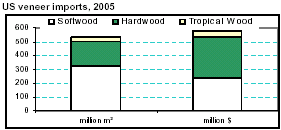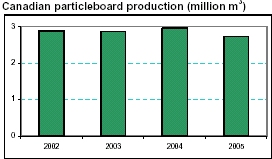|
Analysis of the US tropical veneer market - Part I
This is the first part of an analysis of the US tropical veneer market. The USA imported 534 million m2 ($575 million) of veneer in 2005, up 22% from 2002 (up 26% in value). This implies that the average price of imported veneer rose moderately by 3.7% during this period. However, almost two-thirds of the import volume and some 40% of the import value were accounted for by temperate softwood veneer. Another close to one-third of the volume and more than half of the value were accounted for by temperate hardwood veneer while only 5.7% of the volume (30.5 million m2) and 7% of the value ($41 million) was tropical veneer.

Despite the small market share, the competitive position of tropical versus temperate hardwood veneers has improved in recent years. Between 2002 and 2005, imports of tropical wood veneers advanced by over 30% both in volume and value terms, while imports of temperate hardwood veneers contracted 10% in volume terms and increased moderately by 2.8% in value terms.
This was partially due to rising prices of imported temperate hardwood veneers (+12.7%), while prices of tropical veneers dropped marginally (-1.8%), narrowing the price-gap between these competing products. Nevertheless, tropical veneers still claim an average price premium of 25% or more above the average prices of imported temperate hardwood veneers.
On a volume basis, China is by far the most important supplier of tropical veneers to the USA (8.2 million m2 valued at $4.1 million). Chinese tropical veneer is relatively inexpensive and of lesser quality. US imports of tropical veneer from China have been doubling during recent years, both in volume and value terms. Ghana follows China with exports amounting to 6.2 million m2 in 2005. As Ghana¡¯s veneers are much higher priced, it ranks ahead of China in import value ($7.5 million).
Canadian particleboard production (million m3)

There are considerable price differences between supply countries. For instance, the average price of Cote d'Ivoire veneer in January 2006 was $3.93 but that of Chinese veneer was only $0.44.
Particleboard enjoys stable production in Canada
Canada produces less than 3 million m3 of particleboard each year. Production has been fairly stable during recent years. It amounted to 2.88 million m3 in 2002 and 2.73 million m3 in 2005. Particleboard is used in a wide range of products, including kitchen cabinets, household furniture, office furniture, store fixtures and similar products.
Some 97% of the particleboard industry¡¯s output is sold directly to secondary wood processors, many of them under purchasing agreements. Large particleboard users demand from their suppliers the ability to provide sizeable quantities of dependable products on a just-in-time basis, sometimes with a lead time of 72 hours or less. The remaining 3% of particleboard is
distributed through retail outlets such as Home Depot or Rona and used by ¡°do-it-yourselves¡± and small contractors.

Canada and USA end long lumber dispute
Canada and the USA signed a deal in late April that ends more that two decades of dispute over Canadian exports of softwood lumber. In the seven-year agreement, the USA would revoke anti-dumping and countervailing duties that have been in force since 2002. However, an export tax would be imposed if shipments from Canadian regions exceeded specified levels. The tax would vary according to prevailing prices.
Canadian suppliers would be limited to about 34% of the US market. Softwood lumber is used primarily for construction and demand has been spurred in recent years by the US housing boom. The US government has agreed to refund Canadian companies 80% ($4 billion) in duties collected over the past four years. The remaining $1 billion would be split between US lumber producers and funding for timber-marketing initiatives. The deal requires the approval of Canadian provinces involved.
British Columbia and Ontario, two of the biggest exporters, have already indicated their acceptance.
TFG alleges US neglect of tropical forests
Tropical Forest Group (TFG) has alleged that the US Tropical Forest Conservation Act (TFCA), a key component of the Bush Administration¡¯s climate change programme, has been stalled for a year and a half. John- O Niles, TFG¡¯s director, said that the US administration has not signed a new TFCA conservation agreement in 18 months. The Tropical Forest Conservation Act
(TFCA), enacted in 1998, allows certain countries to forego paying back debt owed to the USA in exchange for protecting tropical forests. Since 2000, its budget has ranged from $11 to $20 million per year.
Hayley Nyeholt, TFG¡¯s associate director said that the US administration has recently made statements on its continued contribution to conserve tropical forests worldwide, but only $4 million have been made available for the President¡¯s illegal logging initiative while $20 million was allocated to the TFCA. TFG urged the USA to fully fund the TFCA at $70 million annually and use the money for its purpose.

|